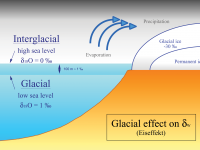
Milutin Milanković (1879 – 1958)
On December 12, 1958, Serbian mathematician, astronomer, climatologist, geophysicist, civil engineer, and popularizer of science Milutin Milanković passed away. Milankovic revolutionized the understanding of climate dynamics. He put the astronomical theory of climate on a firm mathematical basis and founded cosmic climatology by calculating the temperature conditions on planets of the inner and outer solar system. Moreover, he calculated the impact of Earth’s secular orbital cycles on climate changes and explained the origin of the Pleistocene ice ages.
Milutin Milanković – Early Years
Milutin Milanković was born in the village of Dalj in the Austrian-Hungarian Empire as a son of a merchant landlord, and local politician. However, Milutin was mostly raised by his mother and grandmother as his father died when he was only eight. Milanković was educated at home by private teachers and by numerous relatives and friends of the family, some of whom were renowned philosophers, inventors, and poets. He attended secondary school in nearby Osijek, completing it in 1896 and moved to Vienna to study Civil Engineering at the Vienna University of Technology. Afterwards, Milanković attended additional schooling at the Technical University in engineering. He researched and wrote a theoretical evaluation of it as a building material. Milanković was able to finish his Ph.D. thesis with the title ‘Theory of Pressure Curves‘.
What caused the Ice Ages?
Milutin Milanković studied the works of contemporaneous climatologist Julius von Hann and became increasingly enthusiastic about the mystery of ice ages. Despite having valuable data on the distribution of ice ages on Alps, climatologists and geologists could not discover the basic causes — that is. Milanković decided to attempt to correctly calculate the magnitude of such influences. Milanković sought the solution of these complex problems in the field of spherical geometry, celestial mechanics, and theoretical physics. His first work described the present climate on Earth and how the Sun’s rays determine the temperature on Earth’s surface after passing through the atmosphere. Later, Milanković began to search for a mathematical model of a cosmic mechanism to describe the Earth’s climatic and geological history.
World War I and First Publications
In 1916 Milanković published a paper entitled “Investigation of the climate of the planet Mars“. The scientist concluded that: “This large temperature difference between the ground and lower layers of the atmosphere is not unexpected. Great transparency for solar radiation makes that is the climate of Mars very similar to altitudes climate of our Earth.” At the beginning of the First World War in 1914 Milanković was interned because of his Serbian nationality – first in Neusiedl am See, later in Budapest. There he was allowed to work in the library of the Hungarian Academy of Sciences, where the first manuscript about the influence of astronomical cycles on the climate of the earth was written.
Mathematical Theory of Heat Phenomena Produced by Solar Radiation
After World War I, Milanković returned to Belgrade with his family on 19 March 1919. He continued his professorial career, becoming a full professor at the University of Belgrade. From 1912 to 1917, he wrote and published seven papers on mathematical theories of climate both on the Earth and on the other planets. He formulated a precise, numerical climatological model with the capacity for reconstruction of the past and prediction of the future, and established the astronomical theory of climate as a generalized mathematical theory of insolation. Milanković finished a book which was published in 1920, by the Gauthier-Villars in Paris under the title “Théorie mathématique des phénomènes thermiques produits par la radiation solaire” (Mathematical Theory of Heat Phenomena Produced by Solar Radiation). Immediately after the publication of this book in 1920, meteorologists recognized it as a significant contribution to the study of contemporary climate.
Climates of the geological past
Milanković’s works on astronomical explanations of ice ages received support from the climatologist Wladimir Köppen and geophysicist Alfred Wegener.[4] With the support of Köppen, Milanković started the realization of the mathematical description of climate of the Earth in the past. He prepared a graph of solar radiation changes at geographical latitudes of 55°, 60° and 65° north for the past 650,000 years. These curves showed the variations in insolation which were responsible for the series of ice ages. Köppen felt that Milanković’s theoretical approach to solar energy was a logical approach to the problem. His solar curve was introduced in a work entitled “Climates of the geological past“, published by Wladimir Köppen and his son-in-law Alfred Wegener in 1924. Two years later, Köppen proposed to Milankovic to extend his calculations to a million years and to send his results to Barthel Eberl, a geologist studying the Danube basin, as Eberl’s research had unearthed some pre-Ice Ages before over 650,000 years. Eberl published all this in Augsburg in 1930 together with Milankovic’s curves.
Later Years
After the war, Milanković was vice president of the Serbian Academy of Sciences (1948–1958) and became a member of the Commission 7 for celestial mechanics in the International Astronomical Union in 1948. In the same year, he became a member of the Italian Institute of Paleontology. Milutin Milankovic suffered a stroke and died in Belgrade in 1958.
Milankovic’s Legacy
The theory established by Milanković that differences in the radiation budget of the earth, which are caused by the above-mentioned variable orbital parameters, can be used as the sole reason for the ice ages, has proven to be incorrect. It is assumed that the initial warming attributed to the changing orbital parameters will cause greenhouse gases such as carbon dioxide to be emitted, which is responsible for the further heating. It is at least undisputed that the differences in the Earth’s radiation budget have had a decisive influence on the climate of the past and will continue to do so in the future. In this context, his theses also play a role with regard to the greenhouse effect and global warming.
How Ice Ages Happen: The Milankovitch Cycles, [7]
References and Further Reading:
- [1] Life and Scientific Work of Milutin Milanković
- [2] Milancovic’s Theory Hits and Misses
- [3] Alfred Wegener and the Continental Drift, SciHi Blog
- [4] Milanković’s Analysis of Newton’s Law of Universal Gravitation
- [5] Life and Scientific Work of Milutin Milanković
- [6] Milutin Milanković at Wikidata
- [7] How Ice Ages Happen: The Milankovitch Cycles, It’s Just Astronomical! @ youtube
- [8] Federico Foce (October 2007). “Milankovitch’s Theorie der Druckkurven: Good mechanics for masonry architecture – Springer”. Nexus Network Journal. Springerlink.com. 9 (2): 185–210.
- [9] John Imbrie; Katherine Palmer Imbrie (1986). Ice Ages: Solving the Mystery. Harvard University Press
- [10] Timeline of Climatologists, via Wikidata and DBpedia






Pingback: Whewell’s Gazette: Year 03, Vol. #18 | Whewell's Ghost